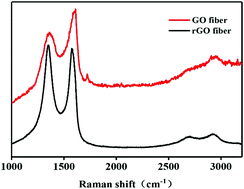Flexible and conductive graphene-based fibers fabricated from pigment and TiO2 PU dual coatings as a colored insulative shell structure†
Abstract
Common graphene fibers are dark black and naked, which limits their application in smart textiles and other electronic devices because of their poor expressive force in colorful clothing. Bare graphene fibers are directly exposed to human skin or other materials during their use, causing a short circuit. Here, we propose a coaxial approach to prepare novel flexible and red reduced graphene oxide (rGO) fibers with a color cover agent – TiO2 slurry and a coloring agent – a pigment/polyurethane paste (rGO–TiO2–pigment/PU) shell, via a dip-coating method. The unique coaxial design of the fiber can not only effectively avoid the risk of a short circuit, but also cover the black color of the inner graphene fibers and give the fibers a red appearance. The core of the coaxial rGO fiber had a high electrical conductivity of 156.6 S cm−1, and the red shell was insulative. The tensile strength of the rGO fiber was 453.39 MPa, while the tensile strength of the red rGO fiber reached 531.31 MPa. According to the CIE 1931 chromaticity diagram, the chromaticity coordinates of the red rGO fibers were x = 0.403 and y = 0.341, which indicated that the color of the red rGO fibers was bright and acceptable in the textile field. The colorful shell has the properties of acid resistance and alkali resistance. The excellent performance of the colorful rGO fibers provides the possibility of creating wearable electronics and conductive textiles and more.



 Please wait while we load your content...
Please wait while we load your content...